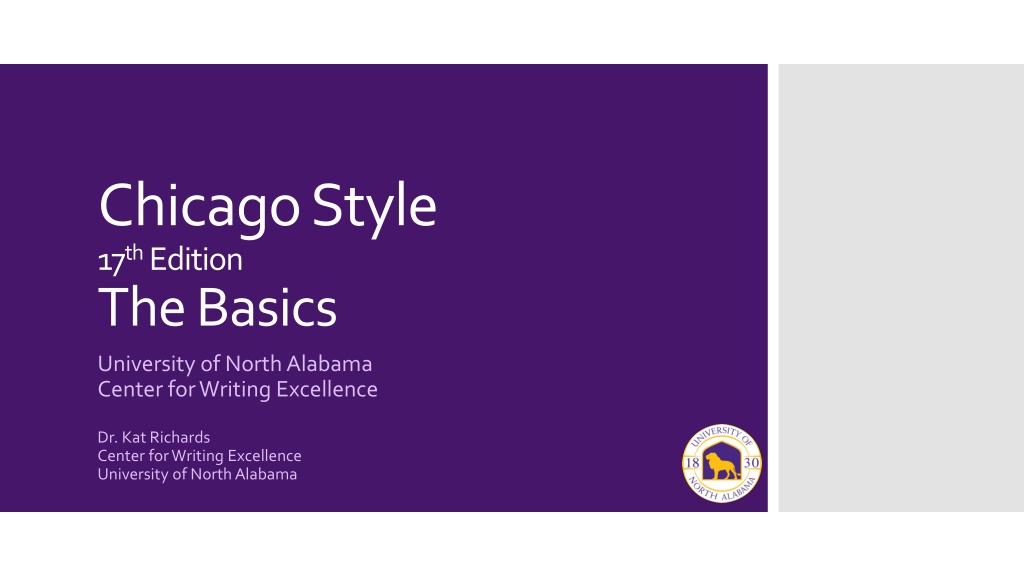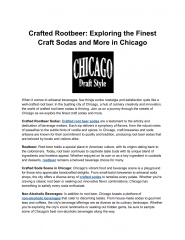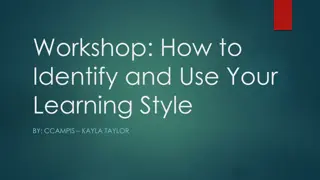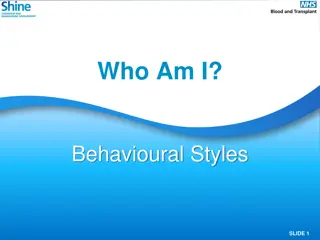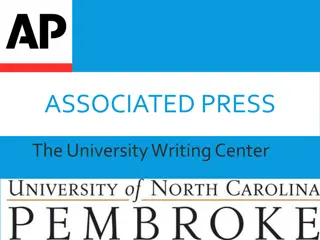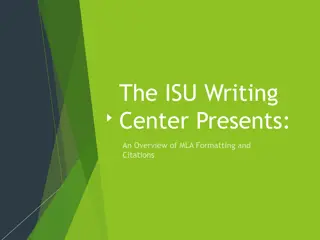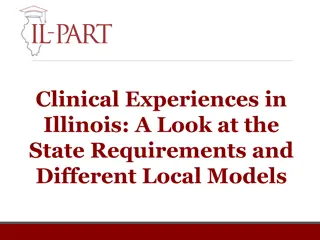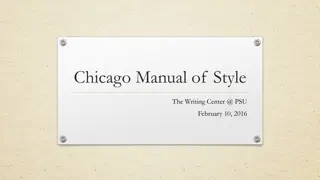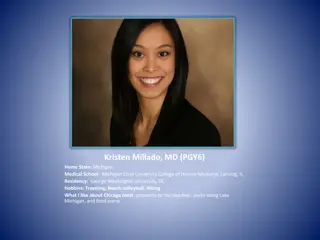Chicago Style: A Comprehensive Guide
Chicago Style, established in 1906, is a widely used citation style in academia, providing guidelines for various disciplines. This guide covers the basics of Chicago Style, including its importance, recommended subtypes, formatting requirements, and more.
Download Presentation

Please find below an Image/Link to download the presentation.
The content on the website is provided AS IS for your information and personal use only. It may not be sold, licensed, or shared on other websites without obtaining consent from the author.If you encounter any issues during the download, it is possible that the publisher has removed the file from their server.
You are allowed to download the files provided on this website for personal or commercial use, subject to the condition that they are used lawfully. All files are the property of their respective owners.
The content on the website is provided AS IS for your information and personal use only. It may not be sold, licensed, or shared on other websites without obtaining consent from the author.
E N D
Presentation Transcript
Chicago Style 17thEdition The Basics University of North Alabama Center for Writing Excellence Dr. Kat Richards Center for Writing Excellence University of North Alabama
Learn what Chicago style is, what it includes, and why it is important Learn about the standard Chicago title page format Learn basic documentation for books, journals, and websites Todays Goals Learn the differences between methods of source integration: summarizing, paraphrasing, and quoting Learn how to use signal phrases and in-text notes to avoid plagiarism
The Chicago Manual of Style, also often called Turabian Style Chicago Style established in 1906 Turabian created in 1937 when Kate L. Turabian assembled a guideline for students at the University of Chicago What is Chicago Style? Why use it? Style provides guidelines for publication in some of the social sciences and natural & physical sciences, but most commonly in the humanities literature, history, and the arts Style lends consistency and makes texts more readable by those who assess or publish them --Purdue OWL. Web Resources. Last modified 2012. https://owl.english.purdue.edu/owl/resource/717/01/ --Turabian, Kate. A Manual for Writers of Research Papers, Theses, and Dissertations. (8th ed.). Chicago: University of Chicago Press., 2013 --p. xiii & iv Turabian 8e
Chicago has two recommended styles or subtypes. Notes-Bibliography System Author-Date System The most common is Notes-Bibliography and this style uses either footnotes or endnotes Chicago Style Footnotes, the most common, are printed at the bottom of the page Endnotes are a collected list at the end of the paper This style also includes a Bibliography page at the end of the paper that lists all references in a format similar to the footnotes found within the paper The Chicago Manual of Style: The Essential Guide for Writers, Editors, and Publishers. 17th ed. Chicago: University of Chicago Press, 2017.
Title (First-Third of the Page) Place the title here in all caps. If there is a subtitle, place a colon at the end of the main title and start the subtitle on the next line. NOT DOUBLE SPACED. Chicago Style Title Page Name and Class Identification (Second-Third of the Page) Author(s) Name(s) Course Number and Title (ex. EN 099: Basic Writing) Date (Month date, year format) --Purdue OWL. General Format. Last Modified 2012. https://owl.english.purdue.edu/owl/resource/717/02/ --Turabian, K. A Manual for Writers of Research Papers, Theses, and Dissertations. (8th ed.). Chicago: University of Chicago Press, 2013.
Chicago Style Title Page --Purdue OWL. General Format. Last Modified 2012. https://owl.english.purdue.edu/owl/resource/717/02/ --Turabian, K. A Manual for Writers of Research Papers, Theses, and Dissertations. (8th ed.). Chicago: University of Chicago Press, 2013.
Body Pages in Chicago Style simply show the page number in the top right corner. The prose of the paper is typically double spaced (unless specified otherwise by your professor) though block quotes (5 or more lines of text) are typed with single spacing. Chicago Body Pages Footnotes are entered at the bottom of the page to show reference. --Turabian, K. A Manual for Writers of Research Papers, Theses, and Dissertations. (8th ed.). Chicago: University of Chicago Press, 2013. --Purdue OWL. General Format. Last Modified 2012. https://owl.english.purdue.edu/owl/resource/717/02/
Chicago Body Pages --Turabian, K. A Manual for Writers of Research Papers, Theses, and Dissertations. (8th ed.). Chicago: University of Chicago Press, 2013. --Purdue OWL. General Format. Last Modified 2012. https://owl.english.purdue.edu/owl/resource/717/02/ --The Chicago Manual of Style: The Essential Guide for Writers, Editors, and Publishers. 17th ed. Chicago: University of Chicago Press, 2017.
With numbers zero through one hundred, as well as certain round multiples of those numbers, Chicago advises spelling out those numbers Ex Thirty-two children from eleven families were packed into eight vintage Beetles. Many people think that seventy is too young to retire. The property is held on a ninety-nine-year lease. According to a recent appraisal, my house is 103 years old. The three new parking lots will provide space for 540 more cars. The population of our village now stands at 5,893. Numbers An alternative rule used my many publications, however, prefer spelling out only single digit numbers, 0-9, and using numerals for anything with tow or more digits --The Chicago Manual of Style: The Essential Guide for Writers, Editors, and Publishers. 17th ed. Chicago: University of Chicago Press, 2017.
There are two ways to format a quote in Chicago: Run-in and block A run-in quote run in to the surrounding text and are enclosed in quotation marks. A block quote is not enclosed in quotation marks. These quotes are distinguished by indenting from the left. Here is an example: Quotations Notice that the continuation of that paragraph stays left aligned and is not indented. --The Chicago Manual of Style: The Essential Guide for Writers, Editors, and Publishers. 17th ed. Chicago: University of Chicago Press, 2017.
Notes and Bibliography System
The Notes and Bibliography method uses notes, whether footnotes or endnotes or both, usually together with a bibliography. The notes allow space for unusual types of sources as well as for commentary on the sources cited. Remember notes start with 1 and continue consecutively. Using Notes In the text Note numbers are superscripted and placed at the end of the clause or sentence to which they refer. Place the superscript after the punctuation (expect after a dash). In the notes Numbers are full sized, not superscript, and follow a period. All lines should be aligned flush with the left side. --The Chicago Manual of Style: The Essential Guide for Writers, Editors, and Publishers. 17th ed. Chicago: University of Chicago Press, 2017.
Example for a Book Notes 1. Author first and last name, Title(Publisher state: Publisher Company, Year published), page range. 2. Brian Grazer and Charles Fishman, A Curious Mind: The Secret to a Bigger Life (New York: Simon & Schuster, 2015), 12. Using Notes Continued For subsequent uses of the same source in the footnotes, use a shortened note. You will use the author s last name, title of the work, and the page range you are referencing. Shortened notes 3. Author last name, Title, page range. 4. Grazer and Fishman, Curious Mind, 37. --The Chicago Manual of Style: The Essential Guide for Writers, Editors, and Publishers. 17th ed. Chicago: University of Chicago Press, 2017.
Here is an example of footnotes Notice the footnotes at the bottom with the superscripts. The corresponding superscript is seen in the text as an indicator to see the footnotes for citation information Footnotes
When using Chicago footnotes, whenever a source is used in a paper, a footnote is inserted to credit the source. Footnotes are shown in text as superscript numbers that relate to a numbered source at the bottom of the page. Using Footnotes in Text The source at the bottom of the page includes much, if not all, of the original bibliographic source information A simple rule: Who, What, Where, When, Which (pages) Authors First and Last Names, Title Title of Periodical, Owner, or Publisher (Date of Publication): XX-XX ((page range)) --The Chicago Manual of Style: The Essential Guide for Writers, Editors, and Publishers. 17th ed. Chicago: University of Chicago Press, 2017.
To enter a footnote (in Microsoft Word), place the cursor at the end of the sentence (after the period) that includes information or ideas from a source. Click References and click Insert Foot Note Using Footnotes in Text (continued) This inserts the superscript number and allows you to insert the corresponding source material at the bottom of the page with the matched number The order the subscript and citations follow is the order they appear in the text
In the first in-text citation note, do the full citation. Whenever the same text is cited again, the note can be shortened to include Author Last Name, Main Title, and Page numbers: 5. Johns, Nature of the Book, 384-85. Using Footnotes in Text (continued) If the footnote immediately preceding is from the same text, list the author s last name, the title of the work, and the page number range. In footnotes proceeding the original note for that author, list it the author last name, title of work, and the page number range, as seen below. 4. Allen Williams, Knowledge from Reading (Los Angeles: Booky Books, 2010), 22-25. 5. Williams, Knowledge from Reading, 54-55.
Endnotes are different than footnotes. Endnotes are notes that are compiled at the end of the chapter, essay, or book. Superscripts will be used in the same way as with the footnotes method. Endnotes Endnotes and footnotes are not usually used together, but can be if required by the publisher or instructor. --The Chicago Manual of Style: The Essential Guide for Writers, Editors, and Publishers. 17th ed. Chicago: University of Chicago Press, 2017.
The bibliography is a list at the end of the paper of sources used The List is labeled Bibliography (centered, no font changes, only on the first page) starts at the top of a new page continues page numbering from the last page of text is alphabetical is single-spaced with two blank lines between the title and the first entry and one blank line between entries Uses a hanging indent (1/2 inch can be formatted from the Paragraph dialog box in MS Word) Bibliography --Turabian, K. A Manual for Writers of Research Papers, Theses, and Dissertations. (8th ed.). Chicago: University of Chicago Press, 2013. --Purdue OWL. General Format. Last Modified 2012. https://owl.english.purdue.edu/owl/resource/717/02/ --The Chicago Manual of Style: The Essential Guide for Writers, Editors, and Publishers. 17th ed. Chicago: University of Chicago Press, 2017.
At the end of the paper you will have a Bibliography where the full citations for your sources are located in alphabetical order. Bibliography entries (in alphabetical order) Grazer, Brian, and Charles Fishman. 2015. A Curious Mind: The Secret to a Bigger Life. New York: Simon & Schuster. Bibliography Continued Smith, Zadie. Swing Time. New York: Penguin Press, 2016. Chicago Manual of styles guide to citing different types of sources with the Notes and Bibliography system can be found here: https://www.chicagomanualofstyle.org/tools_citationguide/citation-guide- 1.html --The Chicago Manual of Style: The Essential Guide for Writers, Editors, and Publishers. 17th ed. Chicago: University of Chicago Press, 2017.
Author and Date System
Sources are briefly cited in the text, usually in parentheses, by author s last name and year of publication. Each in-text citation matches up with an entry in a reference list, where full bibliographic information is provided. Example for a Book Reference list entries (in alphabetical order) Grazer, Brian, and Charles Fishman. 2015. A Curious Mind: The Secret to a Bigger Life. New York: Simon & Schuster. Author-Date System Smith, Zadie. 2016. Swing Time. New York: Penguin Press. In-text citations (Grazer and Fishman 2015, 12) (Smith 2016, 315 16) Chicago Manual of styles guide to citing different types of sources can be found here: https://www.chicagomanualofstyle.org/tools_citationguide/citation- guide-2.html --The Chicago Manual of Style: The Essential Guide for Writers, Editors, and Publishers. 17th ed. Chicago: University of Chicago Press, 2017.
In the Bibliography page, list the first authors name in inverted order (Last name, First name). Then place a comma, and list each following author in standard order (First Name Last Name). Use the conjunction andrather than an ampersand before the final author s name. Ex Kenobi, Obi-wan, Quentin Jinn, Marc Windu, Kermit Mundi, Phil Koon, Kevin Fisto, Documenting Authors Aaliyah Secura, Orville Rancisis, and Lucretia Unduli. [rest of citation goes here] In a Note, list each author s name in standard order. Ex Sue-Ellen James, Thomas Jacobs, and Sally Lang. [rest of citation goes here] --Turabian, K. A Manual for Writers of Research Papers, Theses, and Dissertations. (8th ed.). Chicago: University of Chicago Press, 2013 --The Chicago Manual of Style: The Essential Guide for Writers, Editors, and Publishers. 17th ed. Chicago: University of Chicago Press, 2017.
For works by four to ten persons, all names are given in the bibliography, but in a note, only the name of the first author is included, followed by et al. with no intervening comma. Documenting Authors (continued) Ex Jerry A. Sample et al. [rest of citation here] For works with more than ten authors, CMS recommends that only the first seven be listed in the bibliography, followed by et al. --The Chicago Manual of Style: The Essential Guide for Writers, Editors, and Publishers. 17th ed. Chicago: University of Chicago Press, 2017.
Model for Bibliography Author 1 s Last Name, First Name, Author 2 s First Name Last Name, and Author 3 s First Name Last Name. Title of Book: Subtitle of Book. City: Publisher, Date of Publication. Model for Note Documenting Books Note Number. Author 1 s First Name Last Name, Author 2 s First Name Last Name, and Author 3 s First Name Last Name, Title of Book: Subtitle of Book (City: Publisher, Date of Publication), p#. Example of Note 3. Ash Williams and Raymond Knowby, The Powers of That Book (Wilmington, North Carolina: Necronohaus Books, 1987), 22-25. --The Chicago Manual of Style: The Essential Guide for Writers, Editors, and Publishers. 17th ed. Chicago: University of Chicago Press, 2017.
Model for Bibliography Author 1 s Last Name, First Name. Title of Article/Chapter. In Title of Book, edited by Editor s First Name Last Name, ##-##. City: Publisher, Date of Publication. Documenting Chapters in an Edited Collection Model for Note Note Number. Author s First Name Last Name, Title of Article/Chapter, in Title of Book, ed. Editor s First Name Last Name (City: Publisher, Date of Publication), ##-##. Sample for Note 6. John McClain, Broken Glass, In Trials of Bare Feet, ed. Al Powell (Los Angeles, California: Dude Publishing, 1988), 22-28. --The Chicago Manual of Style: The Essential Guide for Writers, Editors, and Publishers. 17th ed. Chicago: University of Chicago Press, 2017.
Model for Bibliography Author 1 s Last Name, First Name. Title of Article. Title of Periodical volume, number (Date of Publication): XX-XX. Model for Note Documenting Journals Note Number. Author 1 s First Name Last Name, Title of Article, Title of Periodical volume, number (Date of Publication): XX-XX. Sample of Note 1. Robert Koch Jr., Building Connections Through Reflective Writing, Academic Exchange Quarterly 10, no. 3 (2006): 208-213. --The Chicago Manual of Style: The Essential Guide for Writers, Editors, and Publishers. 17th ed. Chicago: University of Chicago Press, 2017.
Model for Bibliography Author s Last name, Author s First Name. Title of Article, Title of Journal Volume, Number (Date of Publication): p##-##. doi: xx.xxxx/xxx.xxx.x.xxx. For articles with no DOI, include a stable URL. Remember to always use the DOI if available. Model for Note Documenting Online Journals Note Number. Author s First Name Last Name, Title of Article: Subtitle, Title of Periodical Volume, Number (Date of Publication): ##, doi: xx.xxxx/xxx.xxx.x.xxx. Sample of Note 1. Minnie Mouse, My Disney Success Beginning in 1950, Life of Disney Quarterly 10, no. 7 (2001): 35, doi: 13.1112/thisismadeup.54362. --The Chicago Manual of Style: The Essential Guide for Writers, Editors, and Publishers. 17th ed. Chicago: University of Chicago Press, 2017.
Bibliography Model for an authored website: Author Last Name, Author First Name. Title of Page. Title of Website or Owner. Last modified Month day, year. URL. Note Model for an authored website: Note Number. Author s First Name Last Name, Title of the Page, Title of Website or Owner, last modified month day, year, Documenting Websites URL. Sample for Note: 8. John Daniels, Nebraska School Children Honored Teacher, Nebraska Family Council, last modified January 18, 2007, www.nebraskafictionnews.com/teacherhonored. No Author? Give the name of the owner of the site. Include as many elements of the citation as you can. --The Chicago Manual of Style: The Essential Guide for Writers, Editors, and Publishers. 17th ed. Chicago: University of Chicago Press, 2017.
Quotations, paraphrases, and summaries provide support for claims or add credibility to your writing refer to work that leads up to the work you are now doing give examples of several points of view on a subject call attention to a position that you wish to agree or disagree with highlight a particularly striking phrase, sentence, or passage by quoting the original distance yourself from the original by quoting it in order to cue readers that the words are not your own expand the breadth or depth of your writing Why Source Integration? --Quoting, paraphrasing, and summarizing. (2004). Purdue University Online Writing Lab. Retrieved September 28, 2007, from http://owl.english.purdue.edu/handouts/research/r_quotprsum.html
1. Read the entire text, noting the key points and main ideas. 2. Summarize in your own words what the single main idea of the essay is. Choosing Text to Integrate 3. Paraphrase important supporting points that come up in the essay. 4. Consider any words, phrases, or brief passages that you believe should be quoted directly. --Quoting, paraphrasing, and summarizing. (2004). Purdue University Online Writing Lab. Retrieved September 28, 2007, from http://owl.english.purdue.edu/handouts/research/r_quotprsum.html
When you summarize, you put the main idea(s) into your own words, including only the main point(s). Summarized ideas must be attributed to the original source. Summaries are significantly shorter than the original. Summaries take a broad overview of source material. Summarizing --Quoting, paraphrasing, and summarizing. (2004). Purdue University Online Writing Lab. Retrieved September 28, 2007, from http://owl.english.purdue.edu/handouts/research/r_quotprsum.html
Paraphrasing involves putting a passage from source material into your own words. Attribute paraphrases to their original sources. Paraphrases are usually shorter than, but may be the same length as, the original passage. Paraphrases take a more focused segment of the source and condense it slightly. Paraphrasing --Quoting, paraphrasing, and summarizing. (2004). Purdue University Online Writing Lab. Retrieved September 28, 2007, from http://owl.english.purdue.edu/handouts/research/r_quotprsum.html
Quotations must be identical to the original. Quotations use a narrow segment of the source. They must match the source document word for word and must be attributed to the original author. Use quotes when the actual words are so integral to the discussion that they cannot be replaced. Use quotes when the author s words are so precisely and accurately stated that they cannot be paraphrased. Quoting --Quoting, paraphrasing, and summarizing. (2004). Purdue University Online Writing Lab. Retrieved September 28, 2007, from http://owl.english.purdue.edu/handouts/research/r_quotprsum.html
Quoting, paraphrasing, and summarizing. Purdue University Online Writing Lab, 2007. http://owl.english.purdue.edu/handouts/research/r_quotprsum.ht ml Turabian, Kate. A Manual for Writers of Research Papers, Theses, and Dissertations. 8th ed.Chicago: University of Chicago Press, 2013. References University of Chicago. The Chicago Manual of Style: The Essential Guide for Writers, Editors, and Publishers. 17th ed. Chicago: University of Chicago Press, 2017.
